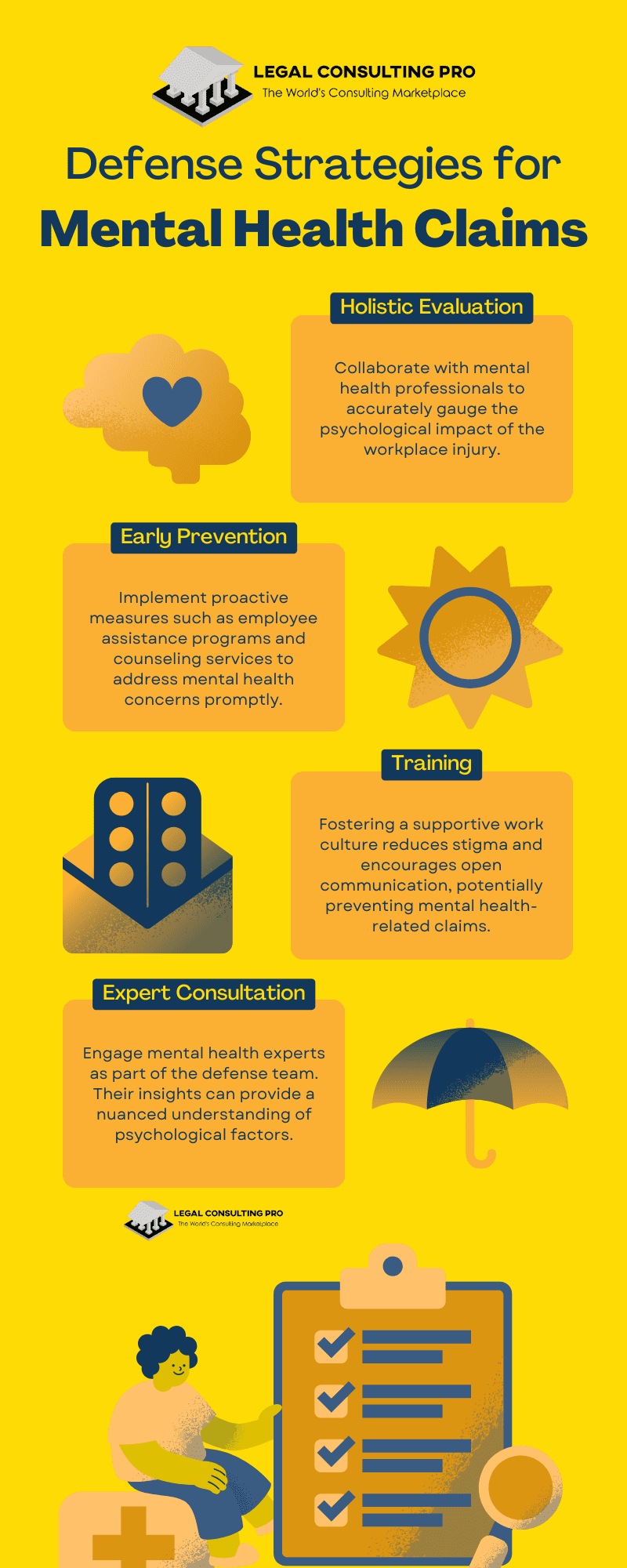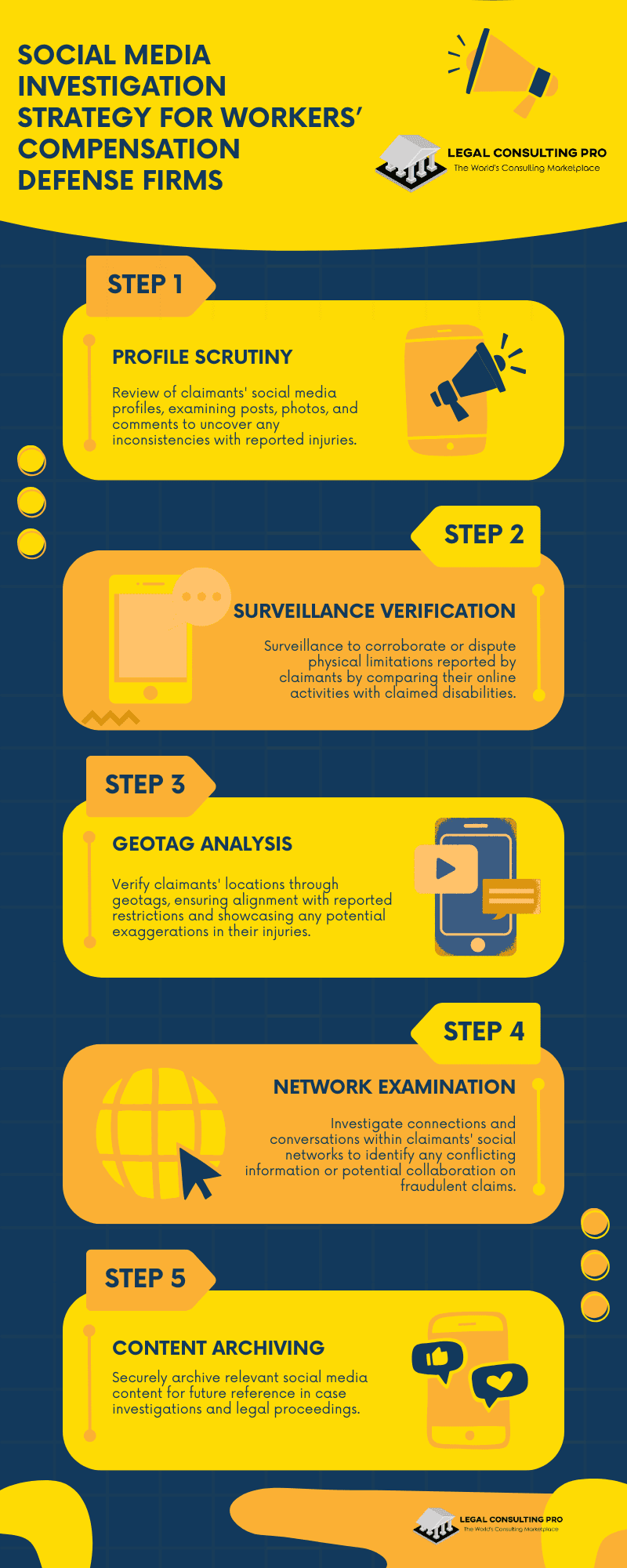Introduction
In the complex landscape of workers’ compensation, staying abreast of evolving defense trends is crucial for legal professionals, employers, and insurers alike. As the dynamics of the workforce continue to shift and legal frameworks adapt, understanding these trends becomes paramount. This blog aims to shed light on 10 workers’ compensation defense trends that might have slipped under your radar.
Brief Overview of the Importance
Workers’ compensation is a multifaceted domain, shaped by legal nuances, emerging technologies, and societal changes. Remaining informed about defense trends is more than a professional obligation; it is a strategic imperative. Adapting to the evolving landscape ensures that organizations can protect their assets, navigate legal complexities, and uphold their duty of care to employees. In an era where litigation is on the rise, proactively understanding and incorporating these trends can be the key to a robust defense strategy.
Purpose of the Blog
This blog aims to illuminate 10 workers’ compensation defense trends that may not be receiving the attention they deserve. From advancements in rehabilitation practices to the impact of remote work on claims, we delve into the nuances that can significantly influence defense strategies. By uncovering these lesser-known trends, we empower stakeholders to navigate the evolving terrain of workers’ compensation with knowledge and foresight.
Trend 1: Technology Integration in Claims Management
Emerging Technologies Transforming Claims Management
In the rapidly evolving landscape of workers’ compensation defense, the integration of cutting-edge technologies is reshaping the way claims are managed. From artificial intelligence (AI) to data analytics, these advancements are streamlining processes, enhancing accuracy, and fundamentally altering the approach to case management. AI, for instance, can swiftly analyze vast amounts of data, helping legal professionals identify patterns and make data-driven decisions. The utilization of wearable devices and telehealth applications further facilitates real-time monitoring and early intervention, preventing minor injuries from escalating into major claims.
Impact on Efficiency, Accuracy, and Overall Case Management
The impact of technology on workers’ compensation defense cannot be overstated. Efficiency is significantly improved through automated processes, reducing the time spent on manual tasks and allowing legal professionals to focus on strategic aspects of case management. Moreover, the accuracy of decision-making is heightened as algorithms analyze historical data to predict case outcomes. This not only minimizes errors but also ensures fair and equitable resolutions. As we explore these technological strides, it’s essential to note the positive influence of Legal Consulting Pro’s Deposition Summarization Services.
By offering meticulous summaries, they augment the efficiency of workers’ compensation defense law firms, ensuring comprehensive understanding and effective representation in every case. The integration of such services aligns seamlessly with the broader trend, reinforcing the importance of technological synergy in the defense of workers’ compensation claims.
Trend 2: Mental Health Awareness in Workers’ Compensation Cases
Growing Recognition of Mental Health Issues
In the ever-evolving landscape of workers’ compensation defense, an increasingly prominent trend is the growing recognition of mental health issues in workplace injury cases. Beyond physical injuries, there’s a heightened awareness of the psychological toll that workplace incidents can exact on employees. Employers and legal professionals are acknowledging the importance of addressing mental health concerns as a crucial aspect of comprehensive workers’ compensation claims.
The stigma surrounding mental health is gradually dissipating, prompting a shift towards a more empathetic and holistic approach to workplace injuries. This trend aligns with a broader societal awakening to the significance of mental well-being, emphasizing that the impact of a workplace incident extends beyond the visible physical ramifications.
Adapting Defense Strategies for Mental Health Claims
As mental health considerations gain prominence, defense strategies are evolving to effectively address claims of psychological distress. Legal professionals are integrating mental health experts into their teams to provide nuanced assessments and ensure that the emotional aspects of an incident are thoroughly considered in the claims process. Additionally, workplace policies and safety measures are being revamped to include provisions that cater specifically to mental health, fostering a healthier and more supportive work environment. This trend reflects a progressive approach in workers’ compensation defense, recognizing that a comprehensive defense strategy must encompass both the physical and mental well-being of employees, ensuring justice and fair compensation for all facets of workplace injuries.

Trend 3: Remote Work Challenges and Compensation Claims
Impact of the Rise in Remote Work
The surge in remote work has undeniably transformed the traditional landscape of workers’ compensation, introducing a complex array of challenges. As employees embrace flexible work arrangements, the lines between work and home blur, posing unique questions about the compensability of injuries sustained during remote work hours. This trend demands a reevaluation of how we perceive workplace injuries, urging legal professionals to navigate the intricacies of remote work-related compensation claims.
The home office setting introduces a myriad of potential hazards, from ergonomic issues to the absence of direct employer supervision. Understanding the nuanced impact of remote work on the likelihood and nature of injuries is paramount in shaping effective defense strategies. As the boundaries of the workplace extend beyond the office walls, the need for comprehensive policies addressing remote work-related injuries becomes increasingly evident.
Strategies for Navigating Remote Work-related Injury Cases
In response to the challenges presented by remote work, workers’ compensation defense strategies are undergoing a paradigm shift. Legal professionals are proactively integrating comprehensive remote work policies that outline the responsibilities of both employers and employees in ensuring a safe work environment. Emphasis is placed on educational initiatives, guiding employees on ergonomics, and preventative measures to reduce the risk of injuries.
Moreover, the assessment of compensability is evolving to consider the unique circumstances of remote work. Legal teams are exploring innovative approaches to discern whether an injury occurred within the scope of employment during remote work hours. This might involve leveraging technology to recreate virtual workplace environments for legal assessments or implementing clear communication channels to promptly address and document remote work-related injuries.
Navigating remote work-related compensation claims requires a dynamic and forward-thinking approach. The trend underscores the need for agility in adapting legal frameworks to the evolving nature of work, ensuring that employees are protected, and employers can effectively manage and defend against claims arising from the increasingly prevalent remote work setting.
Trend 4: Emerging Occupational Diseases and Workers’ Compensation
Lesser-Known Occupational Diseases and Their Implications
As the nature of work evolves, so do the occupational health risks that employees face. Trend 4 brings to the forefront lesser-known occupational diseases that demand attention in the realm of workers’ compensation defense. Beyond the familiar injuries, there’s a growing recognition of diseases linked to specific occupations, ranging from chronic conditions to exposure-related illnesses. Understanding these diseases is crucial for a comprehensive defense strategy, as they pose unique challenges in terms of causation, diagnosis, and long-term implications for affected workers.
This trend compels legal professionals to delve deeper into the intricacies of medical causation, requiring a nuanced understanding of how occupational exposures contribute to the development of diseases over time. From respiratory illnesses in specific industries to emerging health risks associated with technological advancements, staying abreast of these occupational diseases is paramount for building robust defense strategies that address the evolving landscape of workplace health risks.
Importance of Staying Informed on Evolving Workplace Health Risks
In the dynamic landscape of workers’ compensation defense, staying informed on emerging occupational diseases is not just a best practice—it’s a strategic imperative. Employers and legal professionals must proactively educate themselves on the evolving health risks associated with various occupations. This knowledge forms the foundation for proactive risk mitigation measures, comprehensive employee education, and the development of defense strategies that anticipate and address the unique challenges posed by emerging occupational diseases. As the workplace evolves, so must our understanding of the health risks it harbors, ensuring a resilient defense against the spectrum of occupational diseases that may impact the workforce.

Trend 5: The Role of Artificial Intelligence in Claims Evaluation
Use of AI in Assessing Claim Validity
In the ever-evolving landscape of workers’ compensation defense, Trend 5 brings into focus the transformative role of Artificial Intelligence (AI) in claims evaluation. AI is revolutionizing the way legal professionals assess the validity of workers’ compensation claims. Through advanced algorithms, AI can rapidly analyze vast datasets, detecting patterns and anomalies that might escape human observation. This not only expedites the claims evaluation process but also enhances accuracy by identifying potential red flags or inconsistencies in a claim.
The application of AI goes beyond traditional methods, offering a dynamic and data-driven approach to determining the legitimacy of a claim. From detecting patterns of fraud to predicting claim outcomes based on historical data, AI emerges as a powerful tool in the arsenal of workers’ compensation defense.
Challenges and Benefits of AI Implementation
While the integration of AI in claims evaluation presents a revolutionary leap forward, it comes with its own set of challenges and benefits. Challenges include concerns about bias in algorithms, data security, and the need for ongoing human oversight to ensure ethical and fair decision-making. However, the benefits are equally compelling—efficiency gains, improved accuracy, and the ability to process large volumes of data swiftly. The trend signifies a paradigm shift in how workers’ compensation claims are evaluated, with AI at the forefront of innovation, offering a promising path toward a more streamlined and effective defense strategy.
Trend 6: Legislative Changes Affecting Workers’ Compensation Defense
Overview of Recent Legislative Changes
In the dynamic realm of workers’ compensation defense, staying ahead means closely monitoring Trend 6: Legislative Changes. Recent shifts in legislation have far-reaching implications for defense strategies. From alterations in compensability criteria to changes in reporting requirements, legal professionals must navigate an evolving landscape shaped by the penultimate power of legislative updates. Understanding the nuances of these changes is pivotal for crafting effective defense strategies that align with the current legal framework.
Need for Adaptability in Response to Evolving Legal Landscapes
The pace of legislative change underscores the imperative for adaptability in workers’ compensation defense. Laws governing workplace injuries are in a perpetual state of flux, responding to societal shifts, economic considerations, and emerging trends. To navigate this complex terrain, defense strategies must be agile, and ready to pivot in response to legislative updates. The ability to interpret and swiftly implement changes ensures that defense approaches remain not only legally sound but also responsive to the evolving needs of both employers and employees.
In essence, Trend 6 emphasizes the symbiotic relationship between legal adaptability and effective defense in the ever-changing landscape of workers’ compensation. Legal professionals who embrace this trend as a call for continuous learning and adaptability are poised to construct resilient defense strategies that stand the test of legislative evolution.
Trend 7: The Growing Importance of Ergonomics in Injury Prevention
Role of Ergonomics in Reducing Workplace Injuries
Trend 7 shines a spotlight on the pivotal role of ergonomics in reshaping the landscape of workers’ compensation defense. Beyond reactive measures, there’s a growing emphasis on proactive injury prevention through ergonomic interventions. Ergonomics, the science of designing work environments to fit the individual, is emerging as a cornerstone in mitigating workplace injuries. By optimizing the interaction between employees and their workstations, ergonomic strategies are proving to be a formidable force in reducing musculoskeletal disorders, repetitive strain injuries, and other ailments that contribute to workers’ compensation claims.
The impact on defense strategies is profound; as workplaces become more attuned to ergonomics, the frequency and severity of injuries decline. This not only translates to cost savings but also enhances the defensibility of claims by demonstrating a commitment to creating a safe and employee-centric work environment.
Best Practices for Integrating Ergonomic Considerations
To fully leverage the benefits of ergonomic practices, workplaces must prioritize education and implementation. Training programs should empower employees to recognize and address ergonomic issues, fostering a culture of proactive injury prevention. Employers can conduct ergonomic assessments, ensuring workstations are tailored to individual needs. Furthermore, integrating ergonomic considerations into return-to-work programs enhances the rehabilitation process, reducing the likelihood of recurrent injuries.
In embracing Trend 7, businesses not only fortify their defense against workers’ compensation claims but also foster a workplace culture that prioritizes the well-being of its most valuable asset—its employees.
Trend 8: Biopsychosocial Assessments in Injury Cases
Use of Biopsychosocial Assessments in Understanding Holistic Impact
Trend 8 spotlights the transformative role of biopsychosocial assessments in the realm of workers’ compensation defense. Beyond traditional medical evaluations, these assessments delve into the holistic impact of injuries, considering not only the physical aspects but also the psychological and social dimensions. This comprehensive approach recognizes that the effects of workplace injuries extend beyond the physical realm, impacting mental health, social interactions, and overall well-being.
Biopsychosocial assessments encompass factors such as the individual’s coping mechanisms, support systems, and the psychological aftermath of an injury. By providing a nuanced understanding of the holistic impact, these assessments offer a more complete picture of the injured party, facilitating a tailored and empathetic approach to workers’ compensation claims.
Influence on Defense Strategies
The integration of biopsychosocial assessments into defense strategies represents a paradigm shift. Legal professionals armed with a comprehensive understanding of the multifaceted impact of injuries can craft more nuanced defense strategies. By acknowledging and addressing the psychological and social dimensions of a case, defense teams can effectively communicate with all stakeholders, fostering a more empathetic and well-rounded resolution. Trend 8 underscores the importance of adopting a holistic perspective in workers’ compensation defense, ensuring that strategies are not only legally robust but also considerate of the broader implications of workplace injuries.
Trend 9: Collaborative Approaches to Return-to-Work Programs
Benefits of Collaborative Return-to-Work Programs
In the realm of workers’ compensation defense, Trend 9 illuminates the transformative impact of collaborative return-to-work programs. Traditionally, return-to-work initiatives have been unilateral, but a paradigm shift is underway. Collaborative approaches involve stakeholders – employers, medical professionals, and employees – working together to facilitate a seamless return-to-work process. This trend recognizes that successful rehabilitation is not solely a legal matter but a collective effort involving various facets of expertise.
The benefits are manifold. Collaborative programs enhance communication among stakeholders, ensuring everyone is aligned on the expectations and goals of the return-to-work process. This transparency fosters trust and reduces the likelihood of disputes, ultimately expediting the employee’s reintegration into the workforce. Additionally, by leveraging the expertise of medical professionals, these programs can tailor rehabilitation plans to individual needs, promoting a swifter and more sustainable return to productivity.
Successful Case Studies and Impact on Overall Outcomes
Several case studies underscore the positive impact of collaborative return-to-work programs. These initiatives not only reduce litigation costs but also contribute to improved employee morale and job satisfaction. Successful reintegration stories abound, illustrating that a collaborative approach not only facilitates a quicker return to work but also ensures a smoother transition for employees recovering from injuries. Trend 9 heralds a new era in workers’ compensation defense, where collaboration becomes a cornerstone, forging stronger, more resilient pathways for injured employees to rejoin the workforce.
Trend 10: Social Media’s Role in Workers’ Compensation Investigations
Increasing Use of Social Media in Investigations
As we navigate the digital age, Trend 10 unveils a paradigm shift in workers’ compensation investigations— the escalating reliance on social media. Employers and insurers are increasingly turning to platforms like Facebook, Twitter, and LinkedIn to gather insights into the veracity of workers’ compensation claims. From monitoring an individual’s daily activities to scrutinizing public posts for potential discrepancies, social media has become a valuable tool in evaluating the legitimacy of injury claims. This trend reflects the evolving nature of evidence gathering, acknowledging the wealth of information individuals willingly share online.
Adaptation of Defense Strategies to the Digital Age
In response to the surge in social media scrutiny, workers’ compensation defense strategies are adapting to the intricacies of the digital landscape. Legal professionals are incorporating social media investigations into their routine fact-finding processes, leveraging digital footprints to corroborate or challenge the narratives presented in claims. However, this trend also demands a nuanced approach, recognizing the need to navigate privacy laws and ethical considerations. Effectively integrating social media into defense strategies marks a shift towards a more holistic and technologically savvy approach in the pursuit of truth in workers’ compensation cases.

Conclusion
As the dynamics of the workforce and legal frameworks continue to evolve, staying informed on these trends is not merely a strategic choice but a professional imperative. Workers’ compensation defense is no longer a static practice; it’s a dynamic interplay of legal acumen, technological integration, and holistic understanding. By embracing these trends, legal professionals can craft robust defense strategies that not only navigate the current legal landscape but also anticipate the shifts on the horizon. In a field where adaptability is paramount, staying ahead ensures not just legal success but also the well-being of the workforce—a shared goal that transcends the complexities of workers’ compensation defense.
Amidst the dynamic trends shaping workers’ compensation defense, Legal Consulting Pro emerges as a vital partner offering a suite of services tailored to the evolving legal landscape. From precise Deposition Summarization to comprehensive Medical Chronologies/Summaries, E-Filing expertise, and efficient Case Management, their services are the cornerstone of a resilient defense strategy. With Legal Consulting Pro, not only do you stay informed about the latest trends, but you also fortify your defense with expert support, ensuring that your approach to workers’ compensation is efficient, accurate, and aligned with the complexities of the digital age. Explore the possibilities, elevate your defense, and let Legal Consulting Pro be your dedicated ally in navigating the intricacies of workers’ compensation law.
BOOK A FREE CALL to experience the Legal Consulting Pro advantage!







































